To create an eco-friendly green roof, you'll need seven essential structural elements. Start with a robust waterproofing membrane to protect your building from moisture. Add a root barrier system to prevent plant damage. Install a drainage layer and filter fabric to manage water flow. Use a lightweight growing medium to support vegetation without overloading the structure. Incorporate a vegetation support structure for plant stability. Finally, enhance your roof's load-bearing capacity to accommodate the added weight. By focusing on these key components, you'll be well on your way to transforming your rooftop into a thriving green space. Dive deeper to reveal the full potential of your eco-friendly oasis.
Robust Waterproofing Membrane
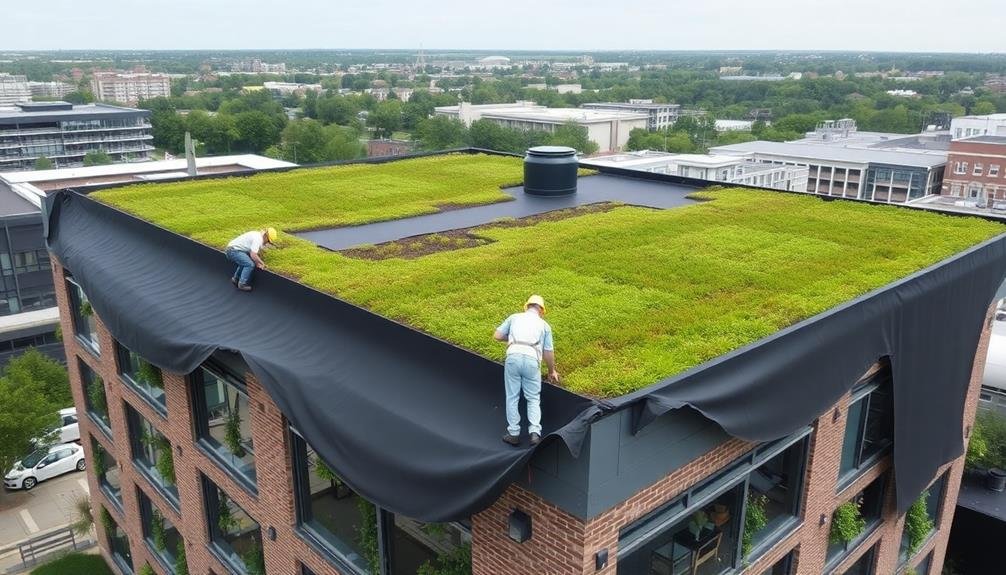
At the heart of any green roof system lies a robust waterproofing membrane. This vital component guarantees your building remains dry and protected from water infiltration. You'll want to choose a high-quality, durable membrane that can withstand the weight of soil, plants, and potential foot traffic.
Look for membranes made from materials like EPDM, TPO, or modified bitumen. These options offer excellent resistance to UV rays, punctures, and root penetration. It's important to select a product specifically designed for green roof applications, as they're formulated to resist degradation from constant moisture exposure.
When installing the membrane, pay close attention to seams and edges. These areas are most vulnerable to leaks, so proper sealing is critical. You'll need to verify the membrane extends up vertical surfaces and is properly terminated to prevent water from seeping behind it.
Consider adding a root barrier layer on top of the waterproofing membrane for extra protection. This will prevent aggressive plant roots from potentially damaging the waterproofing layer.
Root Barrier System
Resilience is key when it comes to a root barrier system for your green roof. This vital layer prevents plant roots from penetrating and potentially damaging the waterproofing membrane below.
You'll want to choose a high-quality, durable material that can withstand the constant pressure of growing roots. Look for root barriers made from polyethylene or polypropylene, as these materials offer excellent resistance to root penetration.
Confirm the barrier is at least 30 mils thick for adequate protection. When installing, overlap the seams by at least 6 inches and seal them properly to prevent any weak points.
Don't forget to extend the root barrier up the sides of any vertical surfaces, such as walls or parapets, to prevent roots from finding their way around the edges.
It's also essential to select a root barrier that's compatible with the specific plants you're using on your green roof.
Drainage Layer

The drainage layer plays an essential role in any green roof system. It's responsible for managing excess water, preventing waterlogging, and guaranteeing proper aeration of the growing medium.
You'll want to choose a drainage layer that's lightweight yet durable, capable of withstanding the weight of the other green roof components and vegetation. Typically, you'll find drainage layers made from materials like recycled plastic, polystyrene, or natural aggregates.
These materials are designed with channels or cups to direct water flow towards roof drains. When selecting a drainage layer, consider its water retention capacity, which helps store water for plant use during dry periods.
The thickness of your drainage layer will depend on the type of green roof you're installing. Extensive green roofs generally require a thinner layer, while intensive green roofs need a thicker one to accommodate larger plants and increased water needs.
You should also guarantee that the drainage layer is compatible with your root barrier and filter fabric to create an effective system. By installing a proper drainage layer, you'll protect your building's structure and promote healthy plant growth on your eco-friendly green roof.
Filter Fabric
A essential component in green roof systems, filter fabric sits between the growing medium and the drainage layer. It's designed to prevent soil particles from washing into and clogging the drainage system while allowing water to pass through freely.
You'll find that high-quality filter fabric is necessary for maintaining your green roof's long-term functionality and efficiency.
When selecting filter fabric for your green roof, consider these key factors:
- Durability: Choose a fabric that can withstand root penetration and environmental stresses.
- Water permeability: Make sure the fabric allows for adequate water flow to prevent waterlogging.
- Soil retention: Look for a fabric with appropriate pore size to effectively hold soil particles in place.
- Chemical resistance: Opt for a material that won't degrade when exposed to fertilizers or other chemicals.
You'll typically find filter fabrics made from synthetic materials like polypropylene or polyester. These materials offer excellent strength and longevity.
It's essential to install the filter fabric properly, overlapping seams and extending it up the sides of the roof to prevent soil migration.
Lightweight Growing Medium

Selecting an appropriate lightweight growing medium is essential for your green roof's success. This specialized soil blend must provide adequate nutrients, water retention, and aeration while minimizing the load on your building's structure.
You'll want to use a mix that's typically composed of inorganic materials like expanded slate, shale, or clay, combined with organic matter such as compost.
The ideal growing medium should have a bulk density between 70-100 pounds per cubic foot when saturated. It must also maintain a proper balance of air and water, with about 20% air space and 20-30% water retention by volume.
You'll need to guarantee the medium has a pH between 6.0 and 8.0 to support a wide range of plants.
When selecting your growing medium, consider factors like your local climate, desired plant types, and roof slope.
For extensive green roofs with shallow depths, opt for a more mineral-based mix. For intensive green roofs supporting larger plants, you may need a higher proportion of organic matter.
Vegetation Support Structure
When planning your green roof's vegetation support structure, you'll need to contemplate three key components.
Start with a root barrier system to protect your roof's waterproofing membrane from plant damage.
Next, choose an appropriate growing medium composition that balances weight, water retention, and nutrient content.
Root Barrier Systems
Root barrier systems play a fundamental role in green roof construction, serving as the foundation for the vegetation support structure. They're designed to protect the underlying roof membrane from plant roots that could potentially penetrate and damage it.
When selecting a root barrier for your green roof, you'll need to take into account several factors to guarantee its effectiveness and longevity.
Key considerations for root barrier systems include:
- Material composition: Choose between synthetic membranes or copper-based materials
- Thickness: Opt for barriers ranging from 30 to 60 mils, depending on the roof's requirements
- Chemical resistance: Confirm the barrier can withstand soil chemicals and fertilizers
- UV stability: Select barriers that won't degrade under prolonged sun exposure
You'll want to install the root barrier directly above the waterproofing layer, guaranteeing complete coverage of the roof surface.
Pay special attention to seams and edges, using appropriate sealants or heat-welding techniques to create a continuous barrier.
Growing Medium Composition
With the root barrier in place, your focus shifts to the growing medium, the heart of your green roof's vegetation support structure. This engineered soil mix is essential for plant growth and roof performance. You'll need a lightweight, well-draining composition that retains enough moisture for plants while preventing waterlogging.
Typical components include inorganic materials like expanded shale, clay, or slate, which provide structure and drainage. Organic matter, such as compost, adds nutrients and water-retention properties. The ratio usually favors inorganic materials (70-80%) over organic (20-30%) to maintain long-term stability and prevent soil compaction.
You'll want to adjust the mix based on your climate, plant selection, and roof load capacity. In arid regions, incorporate more water-retaining materials like perlite or vermiculite. For areas with heavy rainfall, increase the proportion of drainage-enhancing components.
The depth of your growing medium depends on the type of green roof you're installing. Extensive roofs require 3-6 inches, while intensive roofs need 6-12 inches or more.
Drainage Layer Materials
The drainage layer forms an essential component of your green roof's vegetation support structure. It's responsible for managing excess water, preventing waterlogging, and guaranteeing proper aeration for plant roots.
When selecting materials for your drainage layer, you'll need to take into account factors like weight, durability, and water retention capacity.
Common drainage layer materials include:
- Recycled plastic modules: Lightweight and easy to install, these interlocking panels provide excellent drainage and root protection.
- Gravel or pebbles: Natural and cost-effective, they offer good drainage but can be heavy for some roof structures.
- Expanded clay or shale: These lightweight aggregates provide excellent water retention and aeration properties.
- Geo-composite mats: Thin, synthetic mats that combine drainage and root barrier functions in one layer.
Choose a material that complements your roof's load-bearing capacity and climate conditions.
For extensive green roofs with shallow soil depths, opt for lightweight options like plastic modules or geo-composite mats. In contrast, intensive green roofs with deeper soil profiles may benefit from materials with higher water retention capabilities, such as expanded clay.
Always verify your chosen drainage material is compatible with the waterproofing membrane to prevent damage and leaks.
Load-Bearing Capacity Enhancement

To guarantee your green roof's success, you'll need to enhance its load-bearing capacity.
Start by reinforcing the structural support of your building to accommodate the additional weight of soil, plants, and water.
You can achieve this through engineered weight distribution techniques, which strategically allocate the roof's load across key structural elements.
Reinforced Structural Support
In light of the additional weight green roofs impose, reinforced structural support is vital for successful implementation.
You'll need to guarantee your building can handle the extra load, which includes not only the plants and growing medium but also water retention and potential foot traffic.
Consult with a structural engineer to assess your existing roof's capacity and determine the necessary reinforcements.
To reinforce your roof's structural support, consider these key elements:
- Steel beams: Install additional steel beams to distribute the weight evenly across the roof's surface.
- Concrete reinforcement: Add a layer of reinforced concrete to increase load-bearing capacity.
- Column strengthening: Upgrade existing support columns or add new ones to handle the increased load.
- Truss system: Implement a truss system to provide additional support and distribute weight more effectively.
Don't forget to factor in dynamic loads, such as snow accumulation and maintenance equipment.
It's essential to design your reinforced structure to withstand both static and dynamic loads.
Engineered Weight Distribution
Architects and engineers face a crucial challenge when designing green roofs: distributing weight effectively across the structure. You'll need to take into account the combined weight of soil, plants, water, and potential foot traffic. To achieve ideal weight distribution, you should implement a multi-layered system that spreads the load evenly.
Start by incorporating a sturdy, waterproof membrane as your base layer. This will protect the underlying structure and distribute weight across a larger surface area.
Next, add a drainage layer using lightweight materials like expanded clay or recycled plastic. This layer helps manage water retention while minimizing overall weight.
For the growing medium, opt for engineered soil mixes that are lighter than traditional topsoil. These specially designed blends provide essential nutrients for plants while reducing the load on the roof.
You can further enhance weight distribution by using modular planting systems or strategically placed planters.
Don't forget to factor in dynamic loads from maintenance activities and potential snow accumulation. Install walkways and designated maintenance areas to concentrate foot traffic and protect the roof's integrity.
Frequently Asked Questions
How Long Does a Green Roof Typically Last?
You'll find that a well-maintained green roof can last 40-50 years, doubling the lifespan of traditional roofing. It's essential to guarantee proper waterproofing and regular care. Your green roof's longevity depends on its design and upkeep.
Can Green Roofs Be Installed on Existing Buildings?
Yes, you can install green roofs on existing buildings. You'll need to assess the structure's load-bearing capacity and waterproofing. If necessary, you may have to reinforce the roof or make modifications to support the added weight.
What Maintenance Is Required for a Green Roof?
You'll need to regularly water, weed, and fertilize your green roof. It's essential to inspect drainage systems, check for leaks, and trim plants. Don't forget to remove debris and monitor for pests or diseases periodically.
Are Green Roofs Suitable for All Climate Types?
Green roofs aren't suitable for all climates. You'll find they work best in temperate regions. In extreme hot or cold areas, you'll need special adaptations. Consider your local weather patterns before installing one on your building.
How Much Does a Green Roof Installation Usually Cost?
You'll find green roof costs vary widely, typically ranging from $10 to $30 per square foot. Factors like roof size, type of vegetation, and structural requirements will impact your final price. It's best to get multiple quotes.
In Summary
You've now learned about the key structural components for a successful green roof. By incorporating these seven essentials, you'll create a sustainable, long-lasting system that benefits both your building and the environment. Remember, each element plays a vital role in protecting your structure while supporting vibrant plant life. As you plan your green roof, don't skimp on these fundamental layers. They're the foundation for a thriving, eco-friendly rooftop oasis that'll serve you well for years to come.
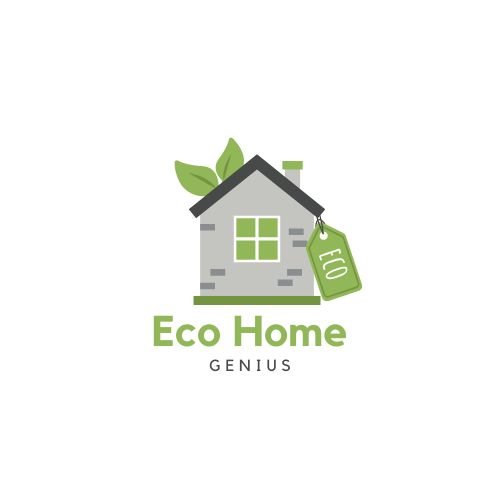

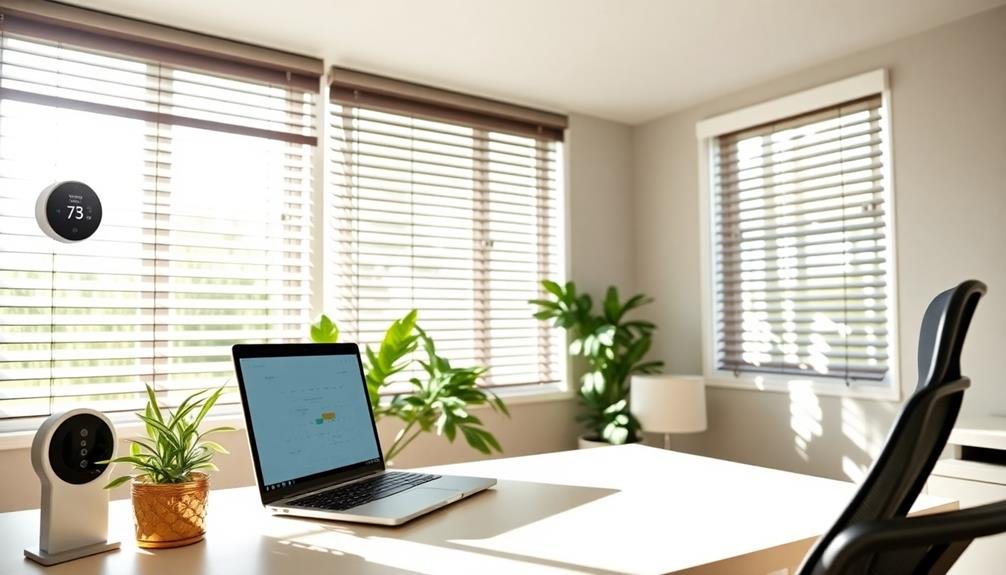
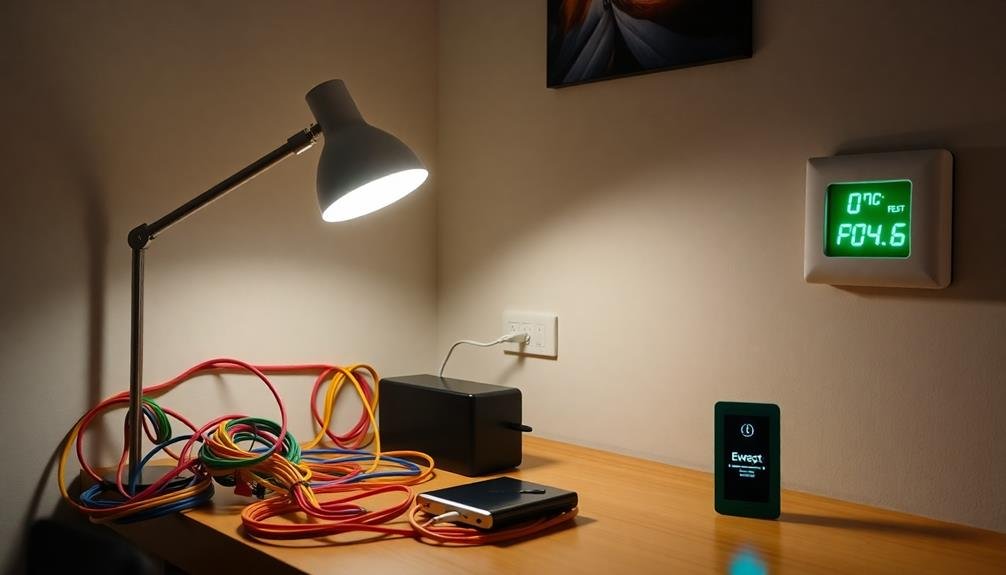
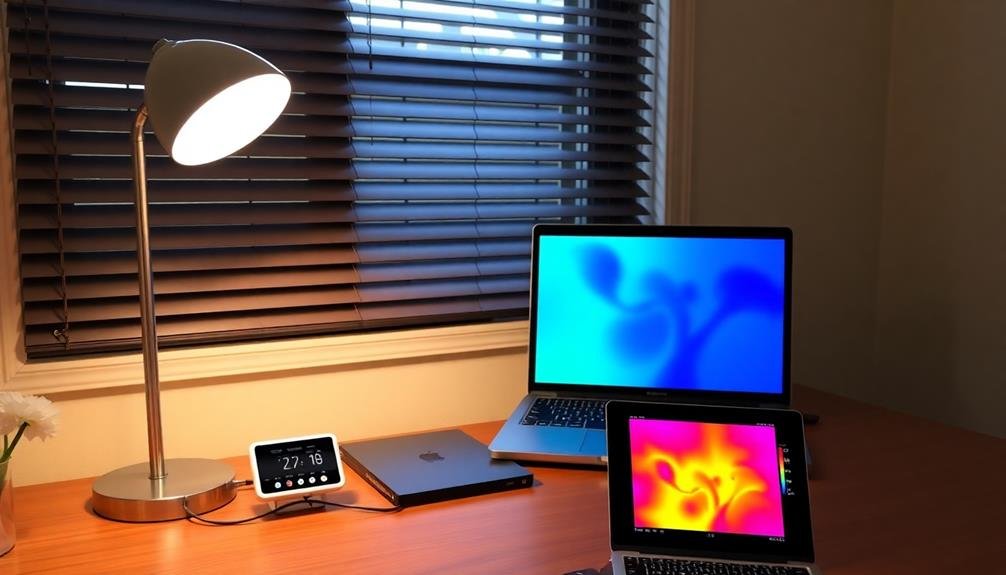
Leave a Reply